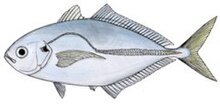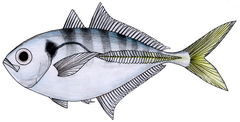en
names in breadcrumbs


Alepes és un gènere de peixos pertanyent a la família dels caràngids.[4]
Del grec alepis (sense escates).[5]
A hores d'ara, només se'n coneix la de l'espècie Alepes kleinii, la qual fresa un sol cop al llarg d'uns pocs mesos i alliberant petits ous transparents i pelàgics.[7]
Es nodreixen de peixos, cefalòpodes, crustacis (com ara, copèpodes, decàpodes i gambes) i tunicats.[6][7]
Són peixos pelàgics que es troben des de prop de la superfície fins als 1.000 m de fondària.[6]
Es troba a les aigües tropicals i subtropicals de l'Índic, el Pacífic, el mar Roig i la mar Mediterrània.[9][6][7]
La seua carn és de bona qualitat i en alguns indrets es comercialitza fresca, assecada o en salaó. No són apreciats pels afeccionats a la pesca esportiva, encara que, de vegades, són emprats com a esquer o capturats accidentalment.[22][7]
Alepes és un gènere de peixos pertanyent a la família dels caràngids.
Alepes is a genus containing five extant species of tropical marine fishes in the jack family, Carangidae. They are commonly known as scads, a term applied to many genera of carangid fishes. Their body form, however, differs from these other scads by being much more ovate in shape, more similar to the larger jacks taken as game fish, although scads are generally much smaller. They are found in coastal waters throughout the Indo-West Pacific region.
Alepes is a genus containing five extant and one extinct species. It is part of the jack family, the Carangidae are part of the order Carangiformes.[3] Recent phylogenetic studies using molecular information have placed Alepes in the subfamily Caranginae (or the tribe Carangini).[4] The most comprehensive study suggests the genus is basal to all other 'scads' and 'horse mackerels' of the genera Trachurus, Decapterus, and Selar, whilst still being closely affiliated with larger members of Caranginae such as Caranx.[5]
Alepes was first created in 1839 by the English naturalist William John Swainson, after he initially proposed it to be a subgenus of Trachinus, which he had created to accommodate Trachinus melanoptera, a species he had just described.[6] Trachinus was invalid, however, as it was already in use for a genus of weevers. This makes A. melanoptera the type species of the genus. The other species currently placed in Alepes were not directly classified in the genus, but were transferred from other, often distantly related genera. Many of these species have numerous junior synonyms.[7] "Alepes" comes from the Greek word alepis, 'without scales'.[8]
A single species has been identified from the fossil record; Alepes pin (Bannikov, 1985), described from the Lower Miocene in eastern Crimean Oblast. This area was once part of the Indian Ocean which extended well into Europe at the time.[9]
There are currently five recognized species in this genus:[10]

The species in Alepes are all relatively small fish, with the largest, A. vari, growing to 56 centimetres (22 in).[8] The other species are much more often encountered at sizes below 20 centimetres (8 in).[11] They have strongly compressed ovate to oblong shaped bodies, with fin arrangements much like the rest of the Carangidae. They have two dorsal fins, the first consisting of weak spines and the second of a single spine followed by a number of soft rays. The anal fin has two detached spines anterior to the main section which consists of one spine and a number of soft rays.[11] Their lateral lines have a moderate to strong anterior curve, with scutes present on the straight section of the lateral line. They are all a blue-green-grey above, fading to silvery white below. Only one, A. kleinni has bands or markings.[12]
The fish in Alepes are all predators, taking a range of crustaceans including copepods, decapods, prawns and shrimp, as well as small fish.[11] At least one species shows a change in feeding intensity over the period of a year.[13] The reproduction of most species is unstudied, except for A. kleinii. This species spawns on a single event over a period of a few months, releasing small transparent, pelagic eggs.[14] Natural spawning behavior in the genus is unknown.
The members of Alepes are all distributed in the tropical to subtropical regions of the Indo-West Pacific region. Their ranges overlap along the Indian, Asian and Indonesian coastlines, although some are distributed as far south as South Africa and northern Australia, while others extend as far north as Japan.[8] Two species, A. djedaba and A. kleinii are known to inhabit the Red Sea, and have passed into the Mediterranean Sea through the Suez canal as part of the Lessepsian migration.[15] They are all coastal species, not found in the open ocean.
The species of Alepes are not of major commercial interest, although Alepes kleinii appears to be taken in substantial enough numbers in India to warrant extensive research. They are taken by a variety of fishing methods including hook and line, trawls and a variety of netting methods.[11] Their flesh is of good quality, and some regions regard various species as high quality and market them fresh, or dried and salted.[16] They are of no interest to recreational fishermen, although occasionally taken as bait or bycatch.
Alepes is a genus containing five extant species of tropical marine fishes in the jack family, Carangidae. They are commonly known as scads, a term applied to many genera of carangid fishes. Their body form, however, differs from these other scads by being much more ovate in shape, more similar to the larger jacks taken as game fish, although scads are generally much smaller. They are found in coastal waters throughout the Indo-West Pacific region.
Alepes è un genere di pesci ossei marini appartenente alla famiglia Carangidae.
I membri del genere si incontrano nelle aree tropicali dell'Indo-Pacifico. A. djedaba e A. kleinii sono presenti nel mar Mediterraneo orientale dove sono penetrate dal mar Rosso in seguito alla migrazione lessepsiana[1].
Alepes è un genere di pesci ossei marini appartenente alla famiglia Carangidae.
Alepiai (lot. Alepes, angl. Crevalles, Scads, Kingfishes, Trevallies) – stauridinių (Carangidae) šeimos žuvų gentis.
Kūnas pailgas, suspaustas, 20-56 cm ilgio, mėlynai žalios, pilkos spalvos; kūno apačia sidabriška. Turi du nugarinius pelekus su minkštais dygliais. Paplitę Indijos vandenyno vakarinėje dalyje ir Ramiojo vandenyno atogrąžų juostos vandenyse.
Gentyje 5 rūšys.
Alepiai (lot. Alepes, angl. Crevalles, Scads, Kingfishes, Trevallies) – stauridinių (Carangidae) šeimos žuvų gentis.
Kūnas pailgas, suspaustas, 20-56 cm ilgio, mėlynai žalios, pilkos spalvos; kūno apačia sidabriška. Turi du nugarinius pelekus su minkštais dygliais. Paplitę Indijos vandenyno vakarinėje dalyje ir Ramiojo vandenyno atogrąžų juostos vandenyse.
Gentyje 5 rūšys.
Alepes is een geslacht van straalvinnige vissen uit de familie van horsmakrelen (Carangidae).[1] Het geslacht is voor het eerst wetenschappelijk beschreven in 1839 door Swainson.
Alepes is een geslacht van straalvinnige vissen uit de familie van horsmakrelen (Carangidae). Het geslacht is voor het eerst wetenschappelijk beschreven in 1839 door Swainson.
Alepes - rodzaj ryb z rodziny ostrobokowatych.
Gatunki zaliczane do tego rodzaju [3]:
Alepes - rodzaj ryb z rodziny ostrobokowatych.
Cá lè ké (Danh pháp khoa học: Alepes) là một chi cá biển trong họ Cá khế. Là các loài bản địa trong vùng biển Thái Bình Dương, chúng sống trong phạm vi 12 hải lý.
Cá lè ké (Danh pháp khoa học: Alepes) là một chi cá biển trong họ Cá khế. Là các loài bản địa trong vùng biển Thái Bình Dương, chúng sống trong phạm vi 12 hải lý.
 分類 界 : 動物界 Animalia 門 : 脊索動物門 Chordata 亜門 : 脊椎動物亜門 Vertebrata 綱 : 条鰭綱 Actinopterygii 目 : スズキ目 Perciformes 亜目 : スズキ亜目 Percoidei 上科 : スズキ上科 Percoidea 科 : アジ科 Carangidae 属 : マブタシマアジ属 Alepes 学名 Alepes
分類 界 : 動物界 Animalia 門 : 脊索動物門 Chordata 亜門 : 脊椎動物亜門 Vertebrata 綱 : 条鰭綱 Actinopterygii 目 : スズキ目 Perciformes 亜目 : スズキ亜目 Percoidei 上科 : スズキ上科 Percoidea 科 : アジ科 Carangidae 属 : マブタシマアジ属 Alepes 学名 Alepesマブタシマアジ属(Alepes)は、アジ科に属し熱帯の海に住む現存5種を含む属である。体は楕円形で、インド洋と西太平洋の沿岸域でみられる。
マブタシマアジ属には、現存の5種と絶滅した1種が含まれ、スズキ目スズキ亜目アジ科に属している。また近年の分子系統学の研究の結果本属はアジ亜科に属するとされた[2]。多くの研究によって本属がマアジ属(Trachurus)、メアジ属(Selar)、ムロアジ属(Decapterus)の祖先であり、ギンガメアジ属(Caranx)などのアジ亜科のより大型の魚にも近縁であることが示唆されている[3]。
マブタシマアジ属はイギリスの博物学者、ウィリアム・ジョン・スウェインソンによって1839年に作られた。本属は当初は彼が記載した新種Trachinus melanopteraを収容するために作られたTrachinus属の亜属として提唱されたものであった[4]。しかし、Trachinusという名はトラキヌス科(スズキ目ワニギス亜目)に含まれる属名として既に使われていたため無効となった。そのため本属に移動されたA. melanopteraが本属のタイプ種となった。現在本属に属している他の種はいずれも直接本属に分類されたのではなく、他の、しばしば遠縁の属から移動されたものである。これらの種の多くは多数の後行シノニムをもつ[5]。属名のAlepesはギリシャ語で「鱗の無い」という意味の単語、"alepis"に由来する[6]。
1種の化石種Alepes pin (Bannikov, 1985)が本属に分類されている。この種はクリミア州東部の中新世の地層から発見された。この地域はかつてヨーロッパまで広がっていたインド洋の一部であった[7]。
現存種では、以下の5種が本属に分類されている[8]。
マブタシマアジ属に属する種は全て比較的小さな種であり、最大種はマブタシマアジ(A.vari)でその最大体長は56cmである[6]。その他の種は20cm以下の個体がみられることが多い[9]。各種は扁平な卵型から楕円形の体型をしており、各ヒレの位置は他のアジ科の魚と類似している。各種は2枚の背鰭をもち、第一背鰭は棘から成り第二背鰭は1本の棘に続いて多数の軟条がある。臀鰭(尻びれ)は、離れて存在する2本の棘と、1本の棘と多数の軟条から成る中心部分から成る[9]。側線は一部でカーブを描き、直線部にはアジ亜科に独特の鱗である稜鱗(英語版)がみられる。体色は各種背部は緑から灰青色で、腹部に行くほど銀色となる。ミヤカミヒラアジ (A.kleinii)のみが体側面に縞をもつ[10]。
マブタシマアジ属の種はすべて肉食魚で、甲殻類や小魚を捕食する[9]。ほとんどの種で、繁殖については研究が進んでいない。しかし、ミヤカミヒラアジについては数か月の産卵期の間に1回、透明で海中を漂う卵を産卵することが分かっている[11]。
マブタシマアジ属の各種はインド洋と太平洋西部の熱帯、亜熱帯域に生息する。生息域にはインド・アジア・インドネシアの沿岸域を含み、南は南アフリカやオーストラリア北部、北は日本まで広がっている[6]。ミヤカミヒラアジとクロボシヒラアジ(A. djedaba)の二種は紅海に生息し、スエズ運河を通って地中海にも生息域を伸ばしていることが知られている[12]。
日本においては、マブタシマアジ、クロボシヒラアジ、ミヤカミヒラアジの三種が分布することが確認されている[13]。
マブタシマアジ属の各種は大きな商業的価値はもたない。しかし、ミヤカミヒラアジはインドにおいて、集中的な研究をするのに足る多量の漁獲がある。それぞれの種はトロール漁をはじめ様々な漁法によって漁獲される[9]。肉は美味であり、本属のいくつかの種が干物や塩漬け、あるいは鮮魚として販売される地域もある[14]。釣りの主対象となることはまれだが、釣り餌に用いるため狙われたり、混獲されることがある。